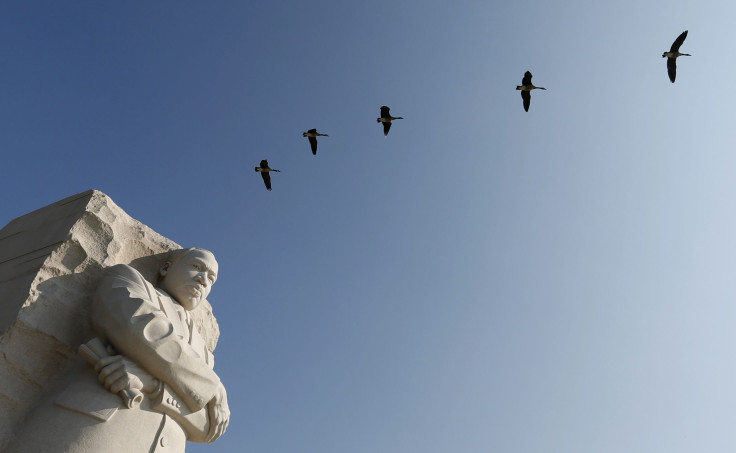How Did Martin Luther King Die? 9 Facts About MLK's Assassination You May Not Have Known

He led the Montgomery Bus Boycott, marched on Washington before giving one of the most famous speeches in American history and was awarded the Nobel Peace Prize, but on April 4, 1968, Martin Luther King Jr.’s life, dedicated to advancing African-American civil rights in the U.S., came to an end when he was assassinated in Memphis, Tennessee. King was in the southern city to give a speech about sanitation workers, and after stepping out on the balcony of the Lorraine Motel where he was staying, he was shot and killed by fugitive James Earl Ray.
King and his dream were not forgotten after his death, and every third Monday of January — around his birthday of Jan. 15 — the U.S. celebrates him with Martin Luther King Jr. Day. Here are some facts you may not know about the American martyr and his assassination.
1. The last people to see him alive: King was supposed to have dinner at the home of Memphis minister Samuel “Billy” Kyles before his assassination. He was standing with Kyles on his balcony of room 306, where King was staying, along with Ralph Abernathy of the Southern Christian Leadership Conference when he was shot, according to Stanford University. Abernathy cradled King’s head as he died.
2. The 40th Academy Awards: Three days after King’s death, a national day of mourning was declared by President Lyndon Johnson. Schools, businesses and libraries closed for the day, and the Academy awards were even postponed, according to Syracuse.com. The award ceremony was pushed back to April 10.
3. King gave his last sermon the day before he was killed: King’s last sermon was given April 3 in Memphis, according to History.com. It was at the sermon where he gave his famous “I’ve Been to the Mountaintop” speech, in which he spoke of nonviolent protests and boycotts.
“We’ve got some difficult days ahead. But it really doesn’t matter with me now, because I’ve been to the mountaintop ... And He’s allowed me to go up to the mountain,” King said. “And I’ve looked over, and I’ve seen the promised land. I may not get there with you. But I want you to know tonight that we, as a people, will get to the promised land.”
Happy Birthday to Martin Luther King, Jr.
He would have been 87 today. #MLK https://t.co/45nqVccI10 pic.twitter.com/6CdSzMhiwZ
— Good Morning America (@GMA) January 15, 2016
4. King faced an assassination attempt years earlier: King was signing copies of his book “Stride Toward Freedom” in 1958 in Harlem when a woman approached him asking if he was Martin Luther King Jr., according to History.com. Izola Ware Curry said she had been looking for King for years before stabbing him in the chest with a 7-inch letter opener. After undergoing hours of surgery and spending weeks recovering in a hospital bed, King said he had no ill will toward the attacker, who was mentally ill.
5. King’s assassin pleaded guilty before eventually withdrawing the plea: James Earl Ray pleaded guilty to King’s death in 1969 to avoid execution in the electric chair, and was instead sentenced to 99 years behind bars. It took him three days to withdraw the plea, saying he was only part of a conspiracy. He requested new trials for the next 29 years, all of which were denied. He died in 1998.
Boston Children’s Chorus pursues ‘raw truth’ in MLK concert https://t.co/CDkpoWhCwJ pic.twitter.com/BJM2NV1taq
— The Boston Globe (@BostonGlobe) January 15, 20166. Lyndon Johnson wasn’t at King’s funeral: Johnson didn’t attend King’s funeral, although he did declare a national day of mourning after the assassination, according to Syracuse.com. He made his way to a memorial service, but because of the unpopular Vietnam War, Johnson didn’t appear in public much at the time.
7. The assassination spot is now home to a museum: The National Civil Rights Museum is built around the former Lorraine Motel where King was assassinated. There is a $15 admission fee for non-Tennessee residents.
8. It is likely his assassin stalked him before the attack: There was a high probability that Ray stalked King before shooting him. The stalking likely would have occurred about March 17, 1968, when he left Los Angeles, and some who knew him in California told investigators that Ray had made comments to them on separate occasions of his plans to travel east, according to the National Archives and Records Administration.
9. After King’s assassination, music helped maintain calm: Many cities across the U.S. saw widespread riots after King’s assassination, but Boston was one that saw relative calm. It is thought that the city saw peace because of a James Brown concert April 5. Boston saw less crime that Friday night than it would have on a typical Friday, according to History.com.
© Copyright IBTimes 2024. All rights reserved.




















